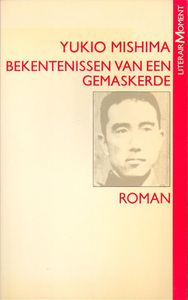You need to sign in or sign up before continuing.
Take a photo of a barcode or cover
dark
reflective
slow-paced
Plot or Character Driven:
Character
Strong character development:
No
Loveable characters:
Complicated
Flaws of characters a main focus:
Yes
I liked it less the second time I read it, probably because the moment of my life I was in then when I first bought it (obsessed with BL, having mood swings and the tendency to sadness, a like for twisted and dark stories). But as for now, whereas it's a good book that explores taboo topics such as sexuality and death, I still didn't feel great emotions from it.
Graphic: Sexual content, Suicidal thoughts, Blood
dark
emotional
reflective
medium-paced
Plot or Character Driven:
Character
Strong character development:
Complicated
Loveable characters:
Complicated
Diverse cast of characters:
No
Flaws of characters a main focus:
Yes
reflective
slow-paced
Plot or Character Driven:
Character
Strong character development:
Yes
Loveable characters:
Complicated
Diverse cast of characters:
Complicated
Flaws of characters a main focus:
Yes
It was a really interesting read (especially the connection between eros and thanatos left a deep impression), but unfortunately I read a quite old German translation from the 1960s, which used outdated, sometimes even derogatory sounding, terms for homosexuality. The whole translation took me really out of the book from time to time - I'm looking forward to reading an English translation or maybe the Japanese orginal someday in the future in order to correct this reading experience
dark
reflective
tense
slow-paced
Plot or Character Driven:
Character
Strong character development:
Complicated
Loveable characters:
No
Diverse cast of characters:
No
Flaws of characters a main focus:
Yes
emotional
reflective
medium-paced
Plot or Character Driven:
Character
Strong character development:
Complicated
Loveable characters:
Complicated
Diverse cast of characters:
N/A
Flaws of characters a main focus:
Yes
4.5/5
In questo romanzo Mishima usa la forma autobiografica, creando forte intimità tra il protagonista e il lettore, che riesce ad immergersi nei suoi pensieri più profondi.
Un viaggio dall’infanzia alla maturità, rievocazione di immagini e ricordi di quotidianità e di scoperta della sua sessualità.
La vista di una riproduzione del San Sebastiano di Reni è ciò che lo inizia all’ autoerotismo e all’ omosessualità. Domande e dubbi sorgono spontanee e la ricerca di risposte porta Kochan ad “osservare” gli altri: sensualità della carne, differenza tra i corpi maschili e femminili.
Proprio per il suo sentirsi “diverso” Kochan decide di vivere la sua vita attraverso una maschera, cercare di apparire come tutti gli altri. Eppure, è proprio questa maschera che rende tutto il romanzo di “dubbia verità”. Come può una maschera fare una confessione veritiera? Questo è il dubbio che viene instillato nella mente del lettore.
La passione spasmodica per la “tragicità”, la morte e la guerra sono il tema “secondario” del romanzo. La bellezza che Kochan ritrova in queste immagini e visioni macabre riflette, in realtà, un attaccamento alla vita. La morte è simbolo di “uguaglianza”.
Lo stile di Mishima colpisce fin dalla prima pagina. Lo stile è descrittivo e melodioso, una introspezione psicologica scritta magnificamente. Una riflessione sul tema dell’omosessualità negli anni della Seconda Guerra Mondiale.
Ancora oggi Mishima riesce a scaldare il mio cuore con le sue parole.
In questo romanzo Mishima usa la forma autobiografica, creando forte intimità tra il protagonista e il lettore, che riesce ad immergersi nei suoi pensieri più profondi.
Un viaggio dall’infanzia alla maturità, rievocazione di immagini e ricordi di quotidianità e di scoperta della sua sessualità.
La vista di una riproduzione del San Sebastiano di Reni è ciò che lo inizia all’ autoerotismo e all’ omosessualità. Domande e dubbi sorgono spontanee e la ricerca di risposte porta Kochan ad “osservare” gli altri: sensualità della carne, differenza tra i corpi maschili e femminili.
Proprio per il suo sentirsi “diverso” Kochan decide di vivere la sua vita attraverso una maschera, cercare di apparire come tutti gli altri. Eppure, è proprio questa maschera che rende tutto il romanzo di “dubbia verità”. Come può una maschera fare una confessione veritiera? Questo è il dubbio che viene instillato nella mente del lettore.
La passione spasmodica per la “tragicità”, la morte e la guerra sono il tema “secondario” del romanzo. La bellezza che Kochan ritrova in queste immagini e visioni macabre riflette, in realtà, un attaccamento alla vita. La morte è simbolo di “uguaglianza”.
Lo stile di Mishima colpisce fin dalla prima pagina. Lo stile è descrittivo e melodioso, una introspezione psicologica scritta magnificamente. Una riflessione sul tema dell’omosessualità negli anni della Seconda Guerra Mondiale.
Ancora oggi Mishima riesce a scaldare il mio cuore con le sue parole.
reflective
slow-paced
Plot or Character Driven:
Character
Strong character development:
No
Loveable characters:
No
Diverse cast of characters:
No
Flaws of characters a main focus:
Complicated
i might write an actual review in the future but the fact that i unknowingly used a tamagotchi as a metaphor for a penis will scar me for life
emotional
informative
reflective
medium-paced
Plot or Character Driven:
Character




